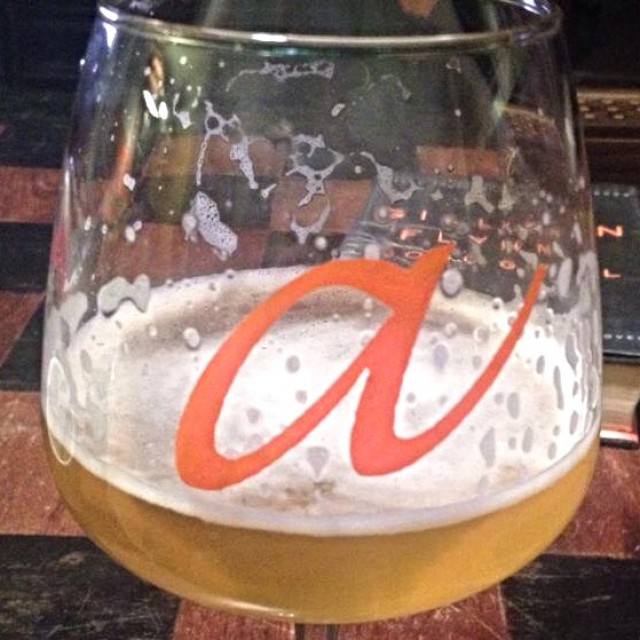My 30th birthday was a few weeks ago, and I wanted to brew something special to mark the occasion. I decided that I'd do 10 gallons of blonde sour, with half of that being fermented entirely spontaneously. To assist in the non-spontaneous portion, I consumed the entire
Drie Fonteinen Armand'4 set so that I could use their dregs. For those not familiar with the series, these were blended solely from Drie Fonteinen-brewed lambic and helped raise money after the
great thermostat incident that wiped out a gut-wrenching amount of lambic.
A blend was created for each season, and at this point (and also fresh, in my recollection) the blends do resemble their seasonal namesakes.
The summer (Zomer, in Dutch) blend is bright and acidic and full of lemon and other citrus.
The autumn (Herfst) is dry, earthy, and a bit leafy, with more pronounced fund and less acidity.
The recipe itself was pretty straightforward. I used about 55% pilsner and 45% wheat, with the latter being split between wheat malt and flaked wheat, as I thought I had more flaked on hand than I actually did. While eventually I'd really like to use raw wheat and do a turbid mash, for this time I used what I had on hand, and then mashed very high (158*F) to keep as many long chain sugars as I could. I had considered adding some flour (perhaps made by processing pilsner malt until it was flour-like consistency) as others have suggested to have some unconverted dextrins for the bugs to get to over time, but I went with what I know for this one.
Otherwise, I used 5oz. of aged Liberty hops that I ordered from Hops Direct a ways back, and also did some slight water adjustments to get roughly in line with the profile given in
Wild Brews.
It was a rough and tumble beginning to the brew process, as it was pouring as I was trying to heat up the mash water. Luckily, by when it was time to heat the sparge water, it was down to a drizzle, and rain didn't bother me too much during the boil.
I definitely wanted to spontaneously ferment a portion of this batch, and had been thinking about that for some time. I had to think of the logistics, as our backyard is fairly wild in that we frequently have raccoons, possums, and other creatures of the night milling about (we live about 100 yards from an old railroad track that's been converted to a trail and has 10-20 feet of woods on each side, and also a neighbor who likes to leave out all sorts of food scraps).
I remembered that we still have a fairly large metal dog cage around from when our dogs were younger, so I fished that out and line the plastic bottom with some towels, as I put two pots (5 gallons in each) directly onto those in the cage after the boil. Knowing that raccoons are crafty little fellows, I also zip-tied the latches for the cage, just in case. Finally, since there was still the possibility of rain, I put a tarp on top of the cage to keep out any overnight rainfall. The whole setup was placed beneath a tree in bloom next to our driveway. Hopefully next year I'll have fruit trees in bloom in the backyard and will be able to use those.
The overnight low was 43*F, plenty cold enough to not have to worry about any thermo bacteria. The next morning, I transferred each half (there's a second pot on the other side of the picture below) to a Better Bottle, pouring through a funnel. Half was left to ferment entirely spontaneously, and the other half received the aforementioned Armand'4 series dregs in addition to the spontaneous culture.
 |
| My "coolship" sitting underneath a tree in bloom. |
The full recipe for the batch:
Batch Number: 85
Brew Date: April 29, 2014
Bottle Date:
Batch Size: 10 Gallon
OG: 1.041
FG: 1.000 (est.)
Fermentation Temperature: Room temperature (60*-70*F)
IBU: 4.3
ABV: 5.2% (est.)
SRM: 3.3
Mash: Single infusion for 60 minutes at 158* F
Boil: 60 minute
Fermentables
10.0 lb Dingeman's Belgian Pilsner
5.5 lb. White Wheat Malt
2.0 lb Wheat, Flaked
Salts & Water
6.0g Sodium Chloride (all into the kettle)
5.5g Gypsum (all into the kettle)
Resulting water profile is as follows:
Mash pH (est.): 5.44
Calcium: 88
Magnesium: 12
Sodium: 7
Chloride: 76
Sulfate: 72
Hops
5.0 oz. Liberty (Aged) at 60 minutes
Yeast
Dregs from the 4 gueuze blends in the Drie Fonteinen Armand'4 Series
Lombard spontaneous culture
Notes
It took a few days, but after 2-3 days, both were fermenting well, and the portion that was entirely spontaneous actually showed signs of fermentation first. Here are a few pictures from 3-4 days in:










